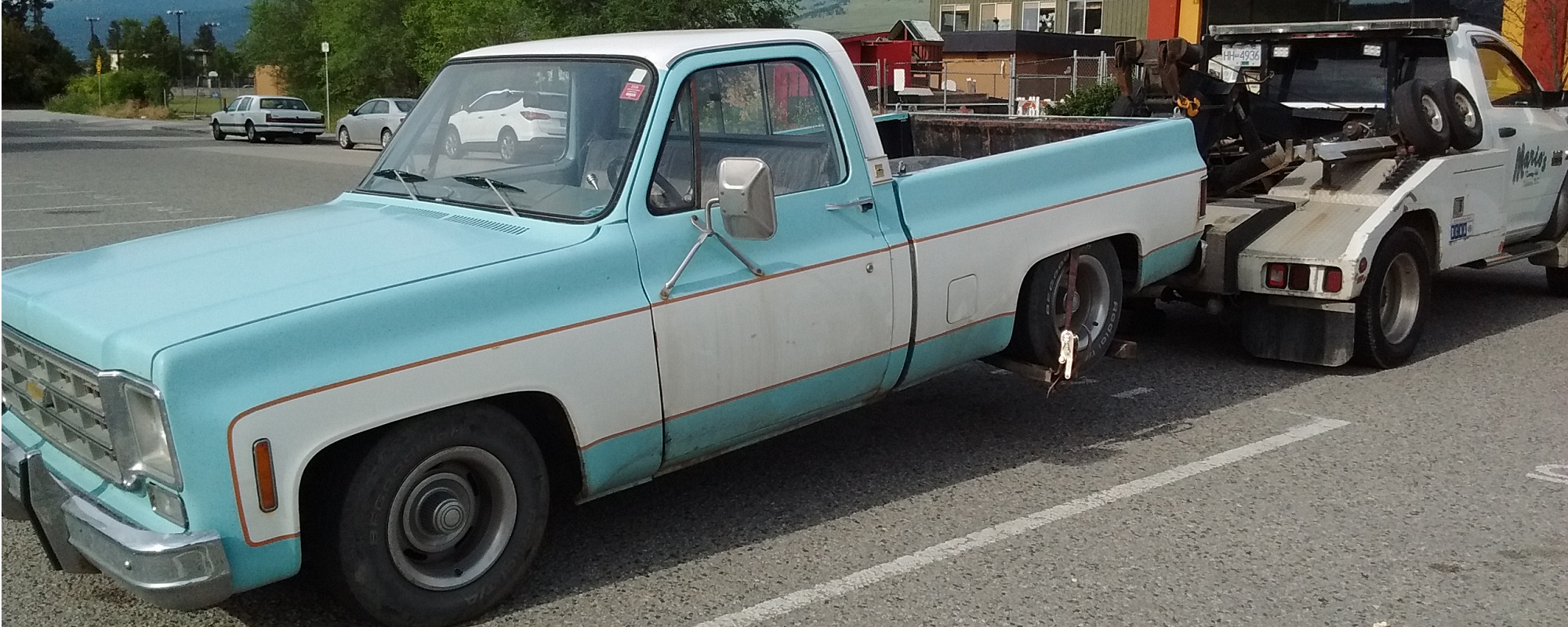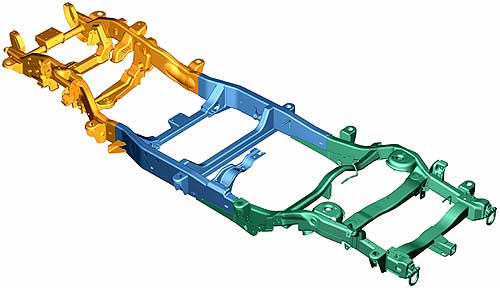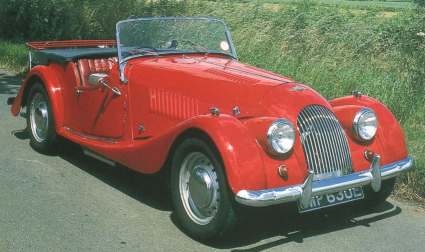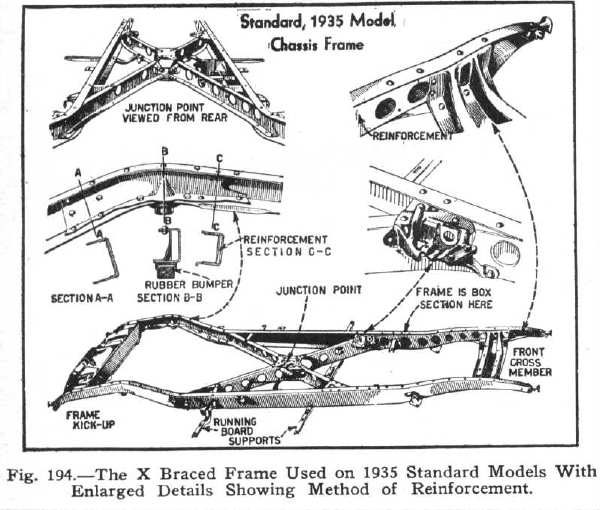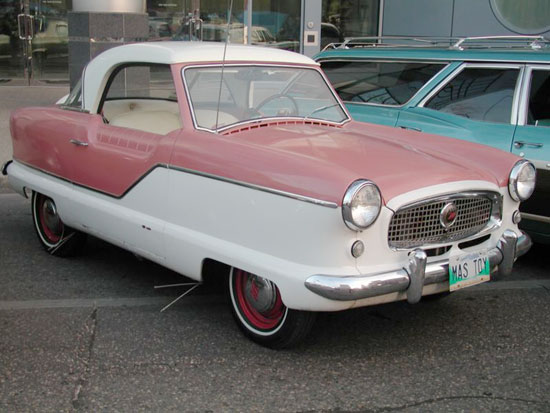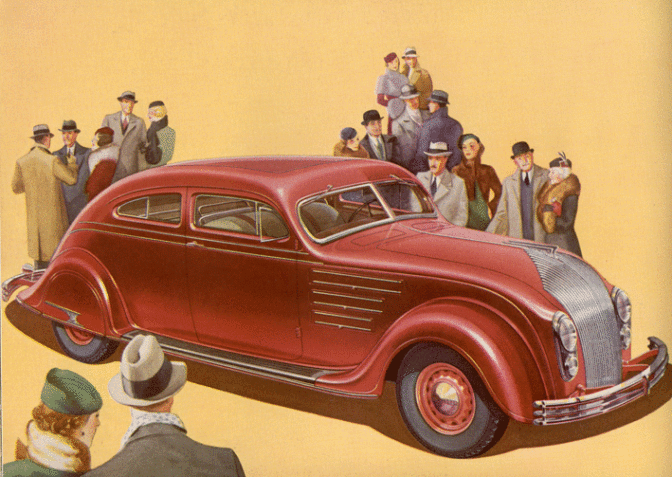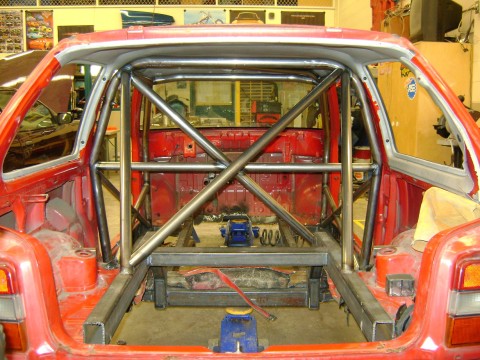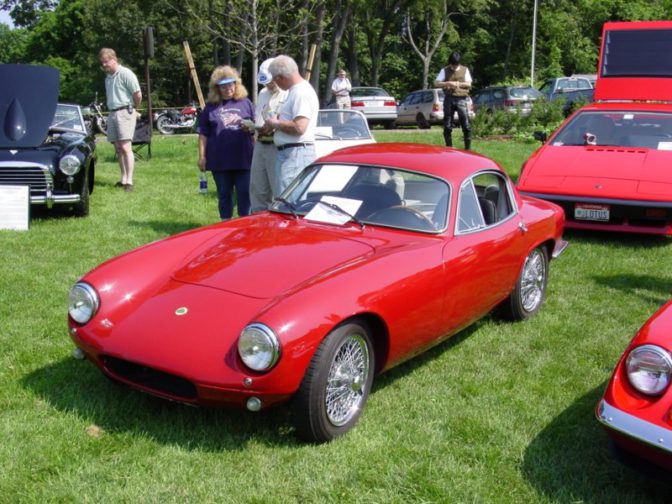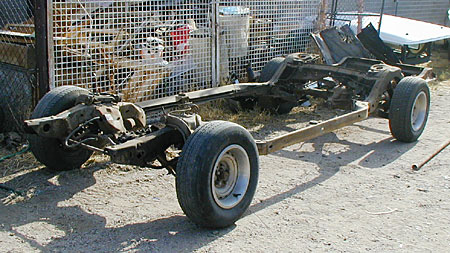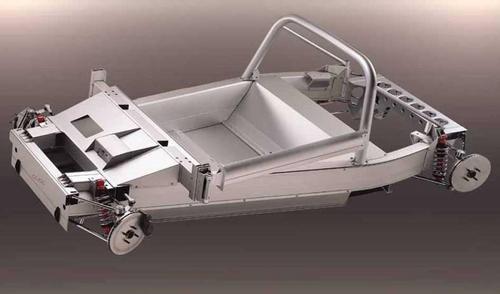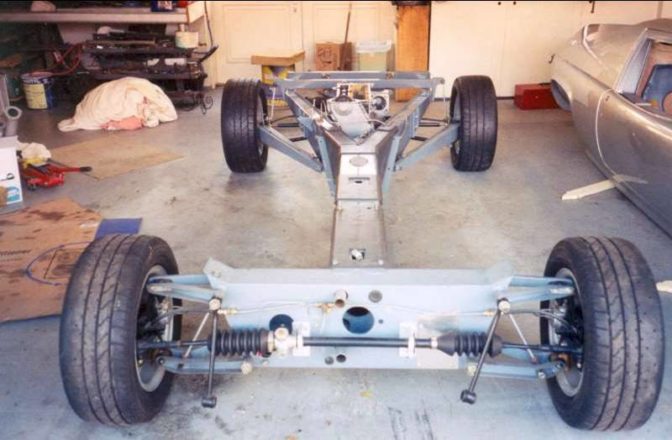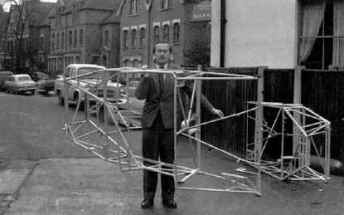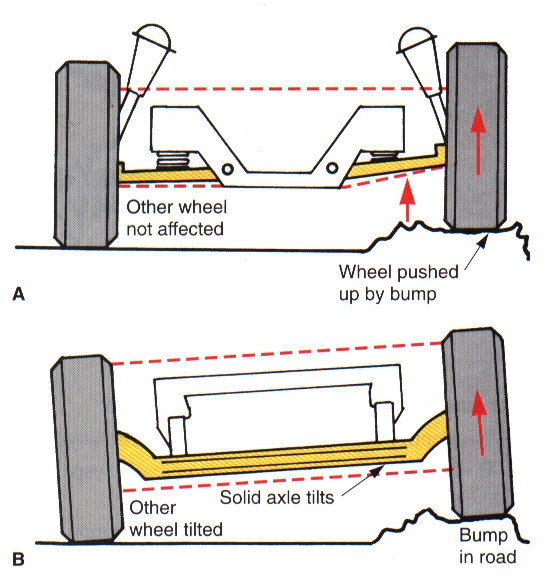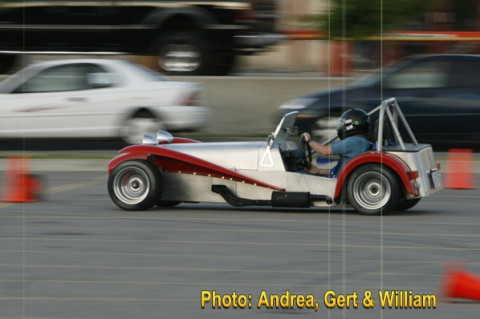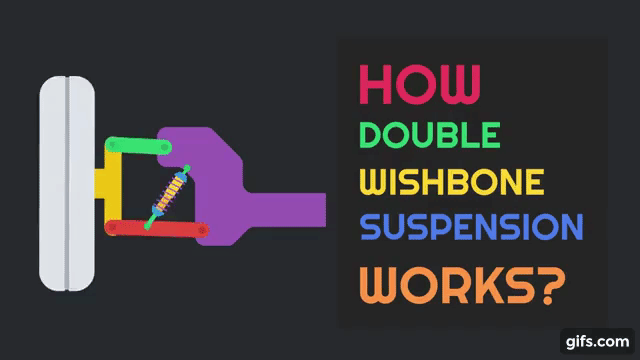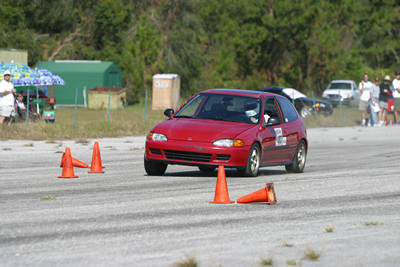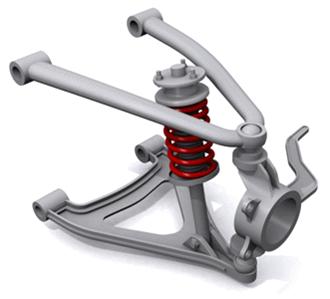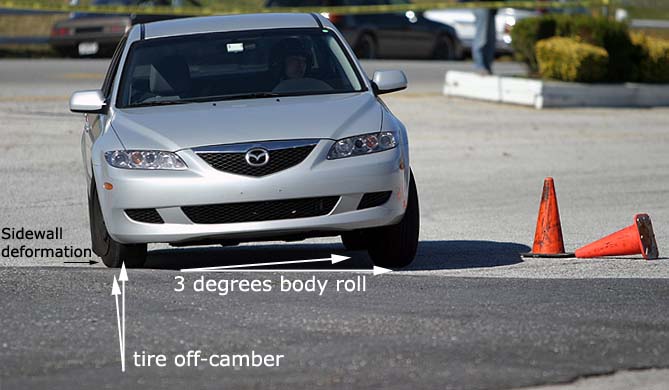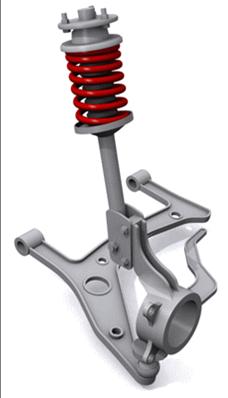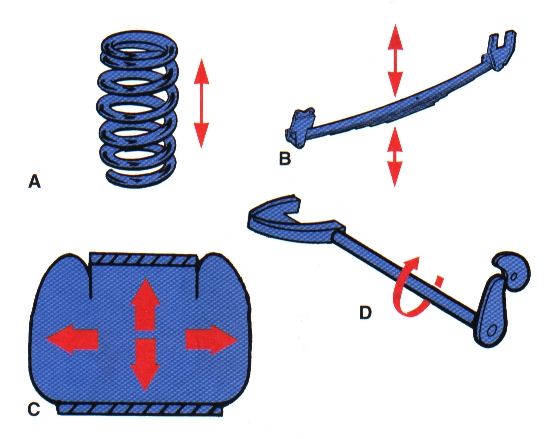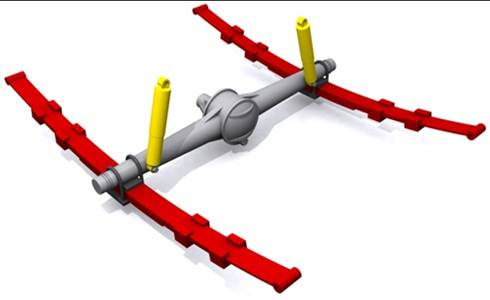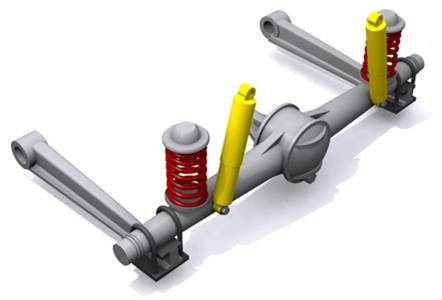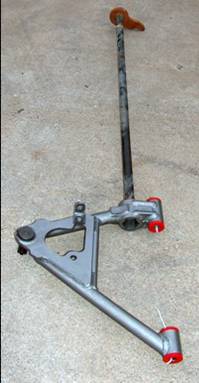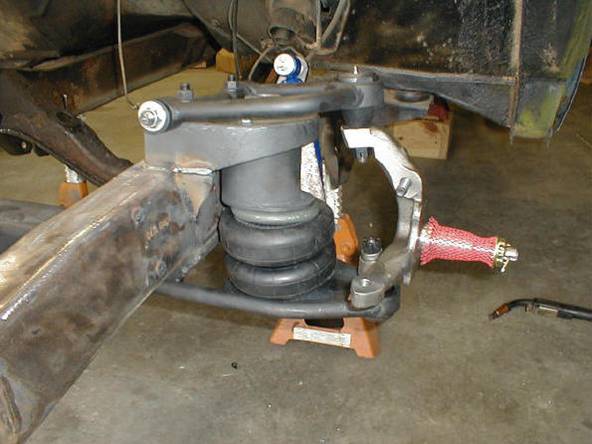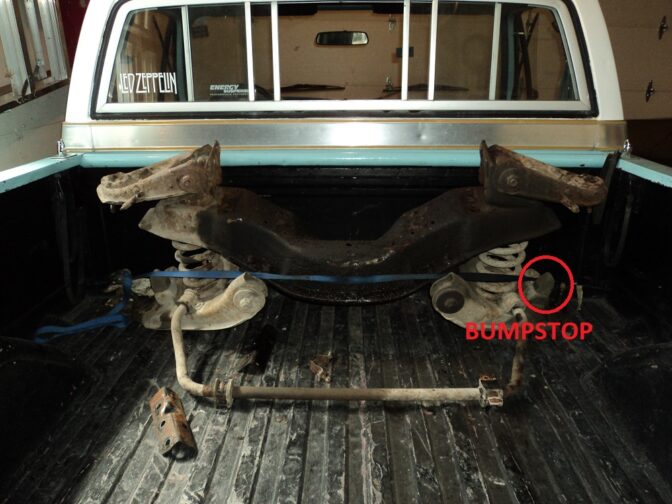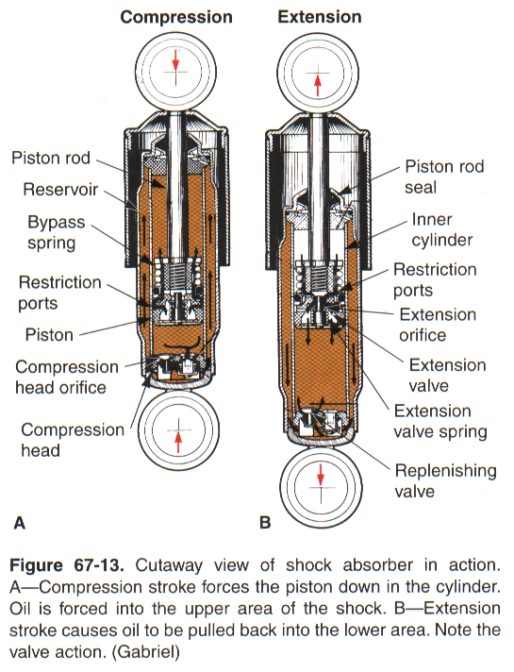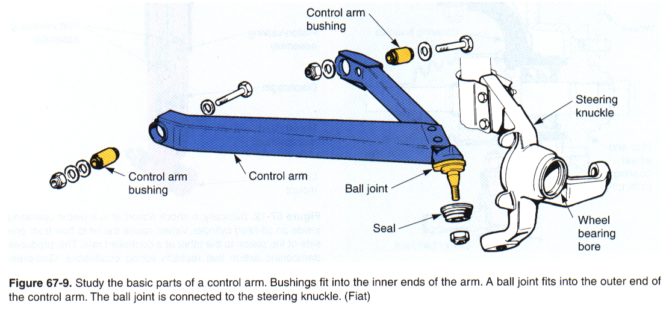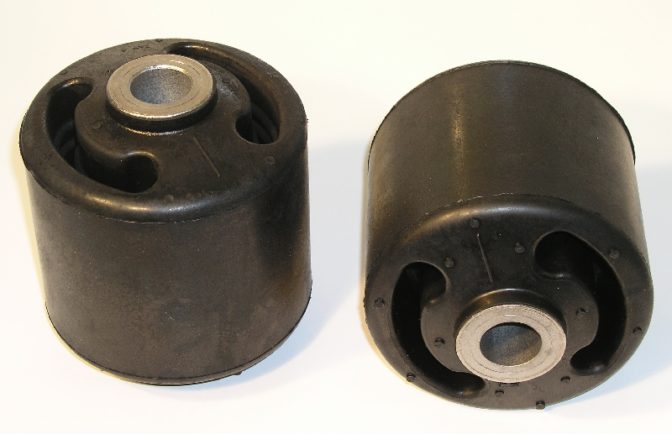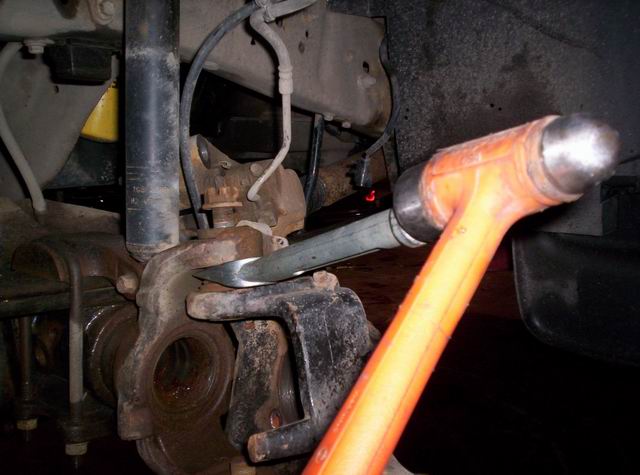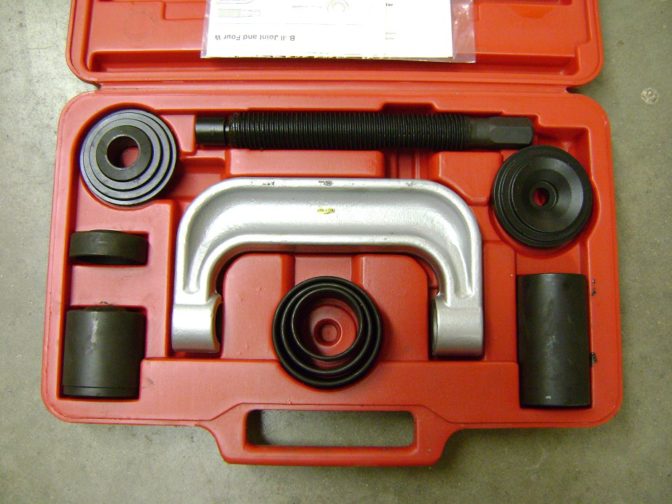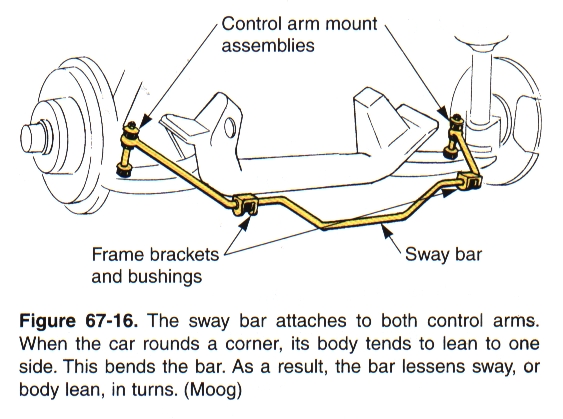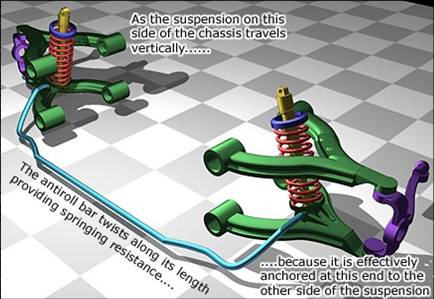[Drivetrain] [Brakes] [Suspension] [Steering] [Electrical] [Emissions]
QUESTIONS – Suspension |
|
We are going to cover:
As always – if something seems unclear, it probably is – so ask me for clarification (then I can make it more clear for others) |
|
PURPOSE |
|
|
The purpose of the suspension is: CONTROL: To keep the tires in contact with the ground at all times COMFORT: To insulate the passenger compartment from bumps Everything about the suspension attaches to the frame. Therefore it is important that the frame is rigid. |
|
FRAMES |
|
|
The frame of the automobile is the main backbone. It acts just like the skeleton of bones we have inside our body. In our body, muscles organs, skin, and millions of blood vessels are attached to our skeleton. The car is very similar. The engine, wheels, body and electrical cables are all attached to the frame. It is the strongest part of the car. As cars grew bigger, longer, and were made to carry more weight the wooden frames were made out of steel in the early 1910’s. The steel shape followed the same shape as the former wood design, which was known as a ladder frame (because it looks like a ladder – we’re that creative). When the early cars were first made, they were mostly old horse drawn wagons with an engine. The frame of the wagon was made of wood that supported the seat, springs and the axles. The early frames were straight, strong pieces of wood running from the front of the car to the back, usually called frame rails. Smaller pieces of wood that connected the two rails were called cross members. The cross members were used to support the engine and transmission. This type of frame kind of looked like a ladder. It was called….. a ladder frame.
The wooden frame was standard in the early cars and continued in some foreign cars until the 1940’s. The last car to use a wooden frame was the English sports car; the Morgan, which used a frame made of ash, until the mid 1970’s.
As the automobile developed engineers realized that some types of cars, especially convertibles, required extra strength in the middle of the car. The “X” rail frame was developed. The extra steel added weight to the car, but it added rigidity and lower center-of-gravity improved handling.
When the early 1950’s came along engineers were quick to develop two new frame styles: The Unibody, and the Perimeter Frame The first style made by Nash, was the unitized construction or unibody.
The unibody is widely used today by most automobile manufactures. The unibody style was designed toward the safety of the passengers, by enclosing them in a steel shell or cabin. The cabin was formed from structural parts, side walls, and a floor pan that would enclose the interior of the passenger section. Steel frame sections would be bolted or welded to this cabin for the trunk, axles and engine. Peugeot, from France used unibody design as early as 1928. The first common North American car to use unibody, was the Chrysler Airflow in the late 1930’s.
My Fiendish Firefly was originally a 1.0L 3-cylinder FWD car, and unibody. When I put the 5.7L V8 and RWD conversion into it, I also fabricated a full ladder frame for it. Which I welded to what was left of the unibody (and added a roll cage for safety). The beer-can thin metal of the unibody cannot hold a V8 safely.
Today: if it’s not a truck, it’s probably a unibody.
The other style that was made in the early 1950’s was called the perimeter frame. This frame was like the old ladder frame but the middle was widened to go around where the passengers sat. This allowed the car to have a lower floor, and sleeker look.
Frames came a long way from the early wood design but their use as the main support for a car never changed. The trucks are still using the basic ladder frame rail for the strong support needed; and race cars have progressed into different materials; like aluminum, magnesium and carbon fiber frames. A strong, rigid frame allows the suspension to do its job properly, vital for a competition car.
|
|
SUSPENSION |
|
|
“Suspension,” when discussing cars, refers to the use of front and rear springs to suspend a vehicle’s “sprung” weight. The springs used on today’s cars and trucks are constructed in a variety of types, shapes, sizes, rates, and capacities. Types include leaf springs, coil springs, air springs, and torsion bars. These are used in sets of four for each vehicle, or they may be paired off in various combinations and are attached by several different mounting techniques. The suspension system also includes shocks and/or struts, and sway bars. The suspension system has two basic functions: CONTROL: To keep the tires in contact with the ground at all times COMFORT: To insulate the passenger compartment from bumps A couple of terms that I’m going to use that you will need to know: BUMP: The suspension moving UP, as it would when you hit a bump. Also referred to as “COMPRESSION.” REBOUND: The suspension moving down, as it would when you come OFF a bump. Also referred to as “DROOP.” A lot of the system’s work is done by the springs. Under normal conditions, the springs support the body of the car evenly by compressing and rebounding with every up-and-down movement. This up-and-down movement, however, causes bouncing and swaying after each bump and is very uncomfortable to the passenger. These undesirable effects are reduced by the shock absorbers. Original suspensions were designed after the horse-drawn buggy, and they handled like it too. Most common was a solid axle on the front and rear. A solid axle is strong and simple; one of the reasons it is still used in heavy trucks today. However, the ride quality is pretty rough due to its “unsprung weight” and a bump on one wheel affecting the whole axle. The original Lotus 7 is criticized for poor ride quality, largely because of the solid axle it has in the back. The car itself weighs so little, that most bumps aren’t absorbed by the springs much at all. Later the front suspension was split, so that each wheel handles bumps independently of the other. This, we call “independent suspension.” Both ride quality and handling are improved. Because the suspension is now independent, the steering became more complex as it had to work independently too. To further improve ride quality and handling, most manufacturers were experimenting with independent rear suspension by the 1960’s. There are two main types of independent suspension in use today:
DOUBLE WISHBONE or SHORT-LONG-ARMThis suspension uses an upper and a lower control arm controlling the motion of the spindle. The arms are usually A-shaped to prevent unwanted fore-and-aft movement. The top arm is usually shorter than the bottom one (also called Short-Long-Arm or SLA suspension) so that in bump, the top of the tire is “tucked in.” This improves handling because when the car is in a turn and the body rolls (that is, leans in a turn), the tire is kept vertical and all the tread stays in contact with the ground.
MacPHERSON STRUTThis suspension is simple, light and cheap. Notice I did not say “good.” It consists of a shock and spring unit (the “strut”) that joins the spindle as one piece. There is no upper control arm. The lower arm may be A-shaped, or I-shaped with a strut rod to prevent for-and-aft movement. This suspension is not designed to “tuck” the tire in during body roll, and thus will never grip as effectively in corners as a double wishbone suspension. The secret to make this suspension work in a performance application is to stop it from moving because it moves badly.
SPRINGSSprings hold the car up. How stiff a spring is is called Spring Rate. Spring rates are engineered according to the intended use of the vehicle and are specifically chosen. A. Coil Springs – Round spring steel wrapped in a coil. They control only suspension movement, and require A-shaped control arms to stop the wheel from flopping around when you accelerate, brake and steer. B. Leaf Springs – Slightly curved flat springs attach to the frame with an eye on one end, and a shackle on the other (to allow the spring to flatten out under bump). The leaf spring does a good job of both locating and controlling the movement of a solid axle. C. Air Bags – an inflatable rubber cylinder, capable of adjusting ride height. The rubber can give a softer ride than a coil spring since it is lighter, but it can also become stiffer in cold weather. This spring controls only suspension motion, not braking, acceleration or steering forces D. Torsion Bars – a length of spring steel anchored to the frame on one end, and anchored to the control arm on the other. The torsion bar “twists” as the control arm moves through bump and rebound. This spring controls only suspension motion, not braking, acceleration or steering forces. Springs support the vehicle weight. They absorb shocks – not the shock absorbers! Springs are usually made unique for each specific make and model of car. They are built according to the weight, distribution, and desired handling characteristics of the car. They should be soft enough to keep the tire in contact with the ground at all times, yet firm enough that the vehicle does not bottom out. Some people lower their vehicle by cutting coils, and others by heating the springs. CLICK TO READ WHY YOU SHOULD NEVER DO THIS!
Oh, and this one is interesting: Hydro Elastic Suspension:
BUMPSTOPSThere are times when you might totally bottom out the suspension travel. Maybe you went over a big jump in your dirt bike, maybe you loaded your truck too heavy, or maybe you spent too much time wandering around Ikea. You need something “soft” to “cushion” the massive impact of the suspension bottoming out. Without some sort of cushion, an abrupt impact will damage things. Kind of like jumping off your parents’ balcony and missing the pile of pillows down below – you’re going to need first aid. Manufacturers use either rubber or closed cell urethane foam as snubbers, or “bump stops.” These are placed in such a way that when everythign has bottomed out, the vehicle is supported by these bump stops – and still stay off the ground so you can still move!
SHOCK ABSORBERSSprings of any kind will continue to oscillate when they absorb a shock. This would make the car pretty nauseous to drive. To control spring oscillation, we use a shock absorber. “Shock Absorber” is not really the correct term, as the springs are what absorb a shock. A better name is “dampers” (that’s what they are called in England) as they “damp” (not dampen – “make wet”) spring oscillation. The shock is a hydraulic cylinder filled with oil. Inside the cylinder is a piston, connected to a shaft which is connected to the chassis. The other end is connected to the suspension. When the shock is compressed, special passages in the piston limit how quickly the oil can flow through the piston. This slows down the movement of the shock, which in turn slows down the spring motion as well. When the oil inside the shock starts leaking out of the top, the seals are gone and the shock is worn out. Worn shocks should always be replaced in pairs (left and right) so the handling of the car is the same when turning left or right. Contrary to popular belief, shocks DO NOT hold up the car. However, shocks play a MAJOR role in how the car rides and handles. A high quality shock can completely transform the performance of a vehicle. Cheap shocks (Monroe “blue”) can cost around $30 each, while a very good performance shock (Koni) would cost $200 each. Ohlins shocks would be about $300 each, whereas top of the line Penske would set you back $1800 or more. Each. A shock needs to control the spring’s motion in both “compression” and “rebound.” Bump is usually fairly soft, so the car can soak up bumps easily. Rebound is a bit firmer, so the car comes off the bump very controlled and stable. A car with too much compression damping will ride very harshly. A car with not enough compression damping will wear out the shocks, and may bottom out more frequently. A car with too much rebound will “pack down” on a bumpy road, possibly even to the point of bottoming out the suspension. A car with not enough rebound damping will feel “floaty” coming off bumps. One way to test your shocks is to drive the car – hit a bump and the vehicle should take no more than two oscillations to settle down. High-end (very expensive) shocks usually stop after one oscillation Shocks have a PHENOMENAL effect on ride quality AND handling. I recommend always getting the best quality shocks you can afford.
You Can’t Have It All… In road racing, shocks are usually soft in bump valving, but very firm in rebound valving. This allows the vehicle to absorb bumps and quick steering inputs without upsetting the vehicle and losing control. In drag racing, shocks are usually very firm in bump valving, but VERY soft in rebound valving. This allows the front of the vehicle to rise quickly and add weight onto the rear wheels for traction. You kind of get one or the other; you cannot have both.
BUSHINGSSuspension arms need to be able to move through bump and rebound. A simple bearing would work well for this, and we use them for upper and lower ball joints at the spindle. Unfortunately, if we used metal bearings everywhere, the driver would hear and feel every movement. Rubber bushings are used on the chassis side of the suspension to insulate the noise from the passenger compartment. The rubber bushings twist as the suspension moves, and eventually deteriorate. When the ride-height of a vehicle is altered, it is important to loosen off all the suspension bushing fasteners to remove any twist, and then re-tighten them when the vehicle is sitting at its new ride height. In a performance application, the rubber is too soft and flexible – polyurethane or even nylon bushings are installed to remove any unwanted compliance in the suspension. Polyurethane and nylon tend to squeak, which can get annoying. These bushings are installed with a special grease to help quiet them. They should be disassembled and re-greased as maintenance.
BALL JOINTSIn order to allow the suspension to move and steer the front wheels, bushings are not enough. We must use a special joint that allows movement in two directions (bumps and turns). A spherical joint (ball and socket) works very well for this. This joint is called a ball joint. Ball joints are designed for their specific purpose. Some carry the load of the vehicle (as in a double-wishbone suspension) while others don’t (as in a MacPherson strut suspension). They are not interchangeable. Ball joints require greasing, and few are “serviceable” today – they are replaced when they are worn out. If they have a grease fitting, they should be greased until the rubber boot just starts to swell – do not burst the boot. If the boot tears and allows dirt and moisture inside, the joint will be ruined quickly DOUBLE WISHBONE: To inspect ball joints, you must first “unload” them. With double wishbone, you must support the vehicle under the CONTROL ARM AT THE BALL JOINT, with the tire off the ground (so the spring isn’t trying to pry the ball joint apart). Then pry the wheel up and down with a long lever, looking for any play. If there is any play at all, the joint is worn out and should be replaced. MACPHERSON STRUT: To “unload” MacStrut ball joints, you must support the vehicle by the FRAME with the tire off the ground. Pry the wheel up and down with a long lever, looking for any play, just as you would with Double-Wishbone. A vehicle with worn ball joints will clunk may try to change lanes when driving over a bumpy surface.
Removing Ball Joints From the Spindle 1: DON’T USE A PICKLE FORK Be SAFE – the ball joints hold Double Wishbone suspensions together. You must support the control arm, with a chain through the coil spring so the spring doesn’t fire into your head when the joint is released. Loosen but do not fully remove the Ball Joint Nut. Keeping the nut on adds an extra element of safety. Using a “pickle fork” to disassemble balljoints usually tears the rubber boot (ruining them) – a better way to remove ball joints is to apply some tension with a long pry bar, then smack the spindle with a BIG hammer. This slightly deforms the tapered hole in the spindle, and the tension helps pop the ball joint out – much like popping a zit by squeezing either side of it. Ewww).
Use hammers!!
Removing Ball Joints from the Control Arm These are usually pressed in, and secured by a snap-ring.Remove the snap ring, and press the joint out. There are “Ball Joint Remover” kits which press the joint out with the control arm still attached to the car.
SWAY BARSAlso called Stabilizer Bars, or Anti-Sway Bars, or Anti-Roll Bars. Used to keep the body from leaning excessively on sharp turns. The main intent of this is to keep the tires in better contact with the road (as the chassis leans, the tires angle off the road, and less tread is contacting the pavement – we’ll talk more about that in Steering). It is a U-shaped bar of spring steel that is connected at the ends to the control arms, and anchored in the middle to the chassis. When the outside wheel goes into bump, that moving control arm tries to raise that end of the bar. The opposite end of the bar, being connected, then tries to lift the inside wheel, thus leveling the car. Or, another way to look at this, is that the sway bar tries to also lift the inside wheel, but is working against the inside wheel’s spring. That spring, then, helps to push the outside wheel back down, thus leveling the car.
Generally speaking, rear-wheel-drive vehicles can improve their handling by adding (or increasing) a front sway bar, and front-wheel-drives can improve with a rear sway bar. MacPherson strut suspensions ALWAYS benefit with a sway bar (because they kinda suck). Generally speaking, larger “performance” sway bars can significantly improve handling WITHOUT negatively affecting ride quality (The “sportier” version of cars usually have bigger bars). Although, at some point, a super mega massive sway bar will begin to hurt ride quality, since it is, in essence, making your independent suspension no longer independent. A serious four-wheeler would want NO sway bars at all, to allow the suspension to move the greatest amount of travel to clear the biggest obstacle. A serious four-wheeler would thus be downright scary to drive on a twisty highway, since the lifted body would be all over the place (the handling is WAY worse).
Oh, and this is kinda cool – Bose made an Electromagnetic Suspension back in the 90’s. It -jumps-: |
|

